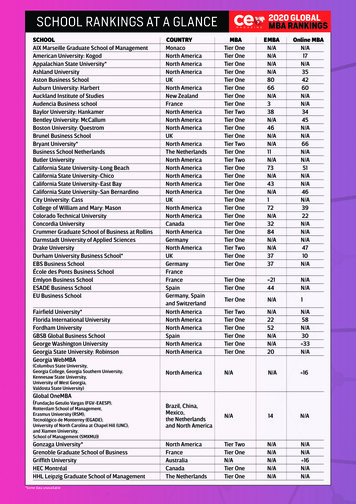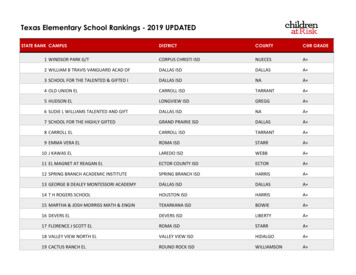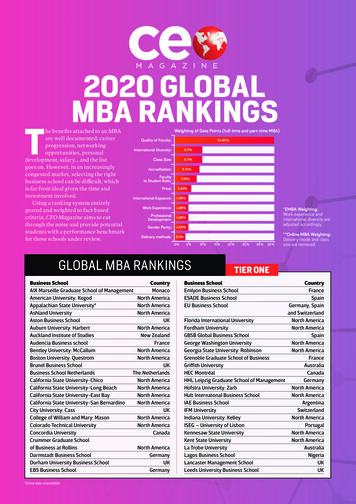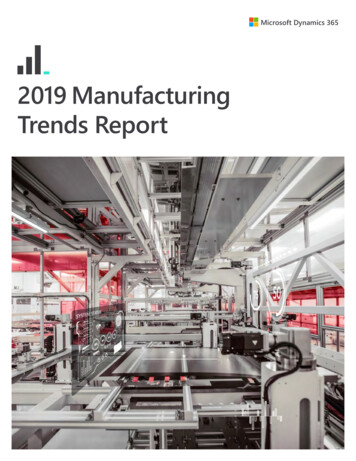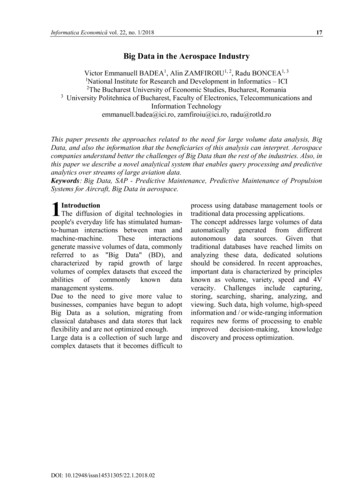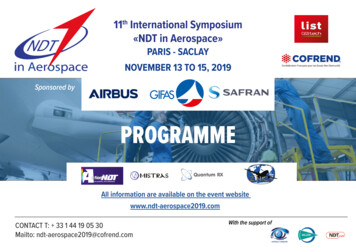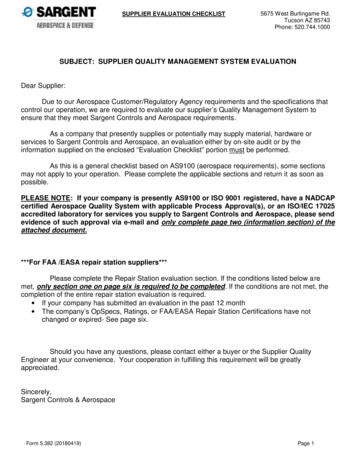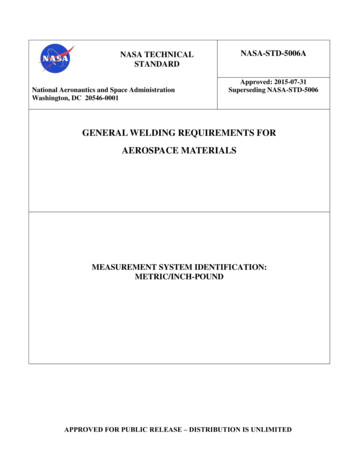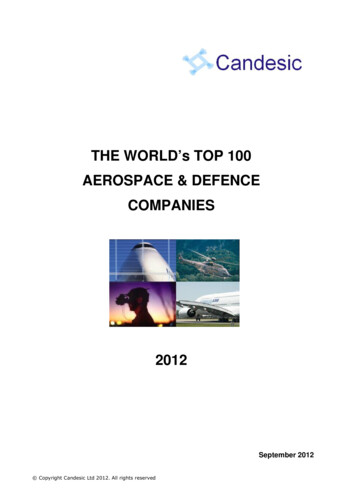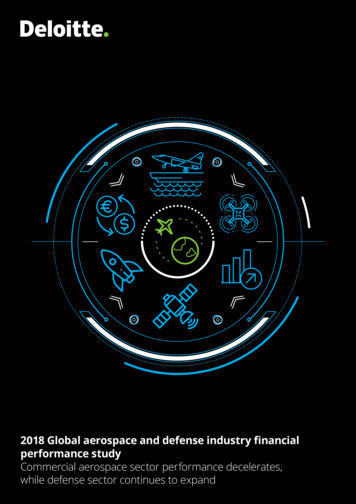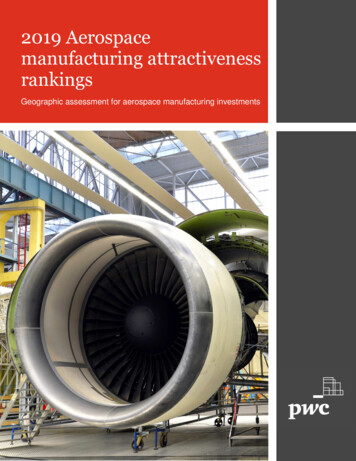
Transcription
2019 Aerospacemanufacturing attractivenessrankingsGeographic assessment for aerospace manufacturing investments
IntroductionThe global Aerospace and Defense (A&D) industryreported record operating profit of 81 billion in 2018, a9% increase over the prior year. The top 100 A&Dcompanies (by revenue) also recorded 760 billion inrevenue, an increase of 9% over 2017. Industryoperating margin improved 10 basis points to 10.7%.1The global A&D industry is expected to show continuedgrowth this year, primarily driven by more defensespending in the US and Europe and projected increasesin aircraft deliveries. Industry growth is also beingbolstered by merger and acquisition activity as well aslower corporate tax rates in the US (which are notreflected in the 2018 data). Commercial revenuepassenger miles grew 6.5% in 2018, about twice globalGDP growth and the fifth consecutive year above 6%.New aircraft deliveries increased 8%, and the industryset a new record of 1,606 large aircraft deliveries. It wasalso the ninth consecutive year of profitability for the USairline industry. 2The 2019 index is based on a weighted score ofcategory and subcategory rankings. Ranking categoriesinclude cost, economy, geopolitical risk, infrastructure,labor, industry, and tax policy. The geopolitical riskcategory has been excluded from the state rankings asthe risk is similar for all the states. The categories arecomprised of many discrete metrics, which are thenaggregated and weighted to arrive at the final rankings.While both state and country rankings use comparablemetrics, there are slight differences in each measure’srelevance to the ranking and the availability ofquantitative information. Further details on themethodology can be found in the Appendices.This report, our sixth edition of annual aerospacemanufacturing attractiveness rankings by countries (orregions) and states in the US, can be a helpful tool inplanning for future growth, enhancing manufacturingsupply chains, and reexamining costs. We hope you findit informative and useful. We welcome your feedback onthe report and how it might impact your strategic plans.12Aerospace and defense year in review 2018 and forecast, PwC, May 2019.FAA Aerospace Forecast, Fiscal Years 2018-2038.PwC 2019 Aerospace manufacturing attractiveness rankings2
Country rankings1-1011-2021-3031-4041-5051-60Top 10 country/region rankings for aerospace 3543Netherlands82414436101221Hong Kong9261519281791South Korea10254322071024OverallRankCostUnited ted KingdomCountry/regionPwC 2019 Aerospace manufacturing attractiveness rankings3
Below is a closer look at the top five countries in our ranking:United StatesUnited KingdomThe US remains the global A&D industry leader, with 244 billion in sales last year. The country’s dominantindustry size is supported by its GDP of 19.5 trillion andstrong domestic transportation infrastructure. The USwas the global leader in A&D exports in 2018,generating 132 billion in revenue. The country’s topranking was also strengthened by a growth ininternational and domestic passenger traffic.With revenues of 46 billion, the UK has a strong A&Dindustry. However, most of its aerospace production isexported, which may be adversely affected by Britain’sexit from the European Union. Uncertainty over Brexitterms and the potential disruption to the country’s globalsupply chains has led to speculation that the industrymay have more difficulty attracting global investmentgoing forward, jeopardizing its production timetables.5However, despite a looming Brexit, the UK DefenseMinister announced in July that the government isinvesting 2 billion through 2025 in a next generationfighter jet, the “Tempest,” and that Britain would seekinternational partners to provide additional funding.CanadaCanada is ranked second in the global A&D industryattractiveness study, supported by an educated laborforce, low level of geopolitical risk, and industry size. In2018, industry revenue increased 7% from the prior yearto reach 18.1 billion. In July 2017, Canada launchedthe Strategic Innovation Fund with a budget of 1.26billion over five years, which encourages R&D efforts tofacilitate the growth and expansion of A&D firms in thecountry and attract and retain large scale investments.SingaporeWith a stable government, strong manufacturing base,and favorable tax policy, Singapore maintains its thirdposition in the rankings. The country is ranked first in thequality of electricity supply and has a healthy GDP yearon-year growth rate of 3.14%. Singapore is Asia’sleading solutions provider for aircraft maintenance,repair and overhaul (MRO) needs, contributing 10% toglobal MRO output.3 This year, local aerospacecompanies, along with government agencies and severalother interested parties, agreed to collaborate on 3Dtechnology that will allow components to be produced ina single piece, accelerating product development andreducing manufacturing costs.4In December 2018, a new initiative was launched inwhich the government agreed to commit up to 125million as part of the Future Flight challenge, which isfocused on developing new technologies, includingdrones and urban air vehicles. The industry is expectedto more than match this investment.6AustraliaAustralia’s ranking is supported by its low costs andrelatively low level of geopolitical risk. In 2018, Australiareleased a long-term vision, “the Defence IndustrialCapability Plan,” to increase the competitiveness of itsdefense industry. As part of this plan, the governmentwill increase defense spending over the next decade,earmarking more than 200 billion for new investment indefense capabilities. In April of this year, Australiaunveiled a full-size model of a new unmanned jet fighter,the first one the country has developed sinceWorld War II.3No.1 in Asia for MRO,” EDB Singapore.“Aerospace sector pushes for 3D technology,” Straits Times, Sept. 22, 2018.5Christopher DeNicolo, David Matthews and William Buck, “Industry Top Trends 2019: Aerospace & Defense,” S&P Global Ratings, Nov.14, 2018.6“Industrial Strategy – Aerospace Sector Deal,” Gov.UK, Department for Business, Energy & Industrial Strategy, Dec. 6, 2018.4PwC 2019 Aerospace manufacturing attractiveness rankings4
Considerations for your businessPassenger growth continues to increase as does globaldefense spending. The current backlog of aircraft orderswill take about 6-8 years to clear even with companieshitting record production levels. The US A&D industryperformed especially well in 2018, with exports totaling 151 billion, an increase of 5.8% from the previous year,accounting for 9% of US exports and yielding a 90billion trade surplus. Although manufacturers have notPwC 2019 Aerospace manufacturing attractiveness rankingsbeen immediately hurt by tariffs, they may need torethink their supply chains longer-term, especially thosein the Asia-Pacific region. The trade situation continuesto evolve rapidly, and companies should have a plan todeal with the potential ramifications of trade wars withvarious countries and areas around the world. Somecompanies may consider reshoring all or part of theirsupply chain as business conditions merit.5
State rankingsS1-1011-2021-3031-4041-52Top 10 State rankings for aerospace dustryEconomyTax 1Indiana61841111072North regon10241714191813StatePwC 2019 Aerospace manufacturing attractiveness rankings6
Below is a closer look at a few notable industry initiatives or other indications of significant growth among the five mosthighly ranked States:WashingtonWashington remains in first place this year, withfavorable rankings in the categories of industry,infrastructure, and economy. With a total workforce ofover 136,000, the state produced 1,400 aircraft andunmanned aerial systems in 2018. It also manufacturednearly 90% (741) of all commercial aircraft in the US. Inorder to promote innovation, the state offers favorabletax policies, such as tax credits for pre-productiondevelopment expenditures, and support for severalpublic-private partnerships. The state is host to majorplayers, such as Blue Origin and Boeing CommercialAirplanes (BCA) as well as home-grown companies,including Spaceflight Industries and PlanetaryResources. Boeing is not only the largest privateemployer in the state, but also the world’s largest aircraftmanufacturer. The company set an industry record in2018 for delivering 806 commercial airplanes andregistering revenues of 101 billion.7GeorgiaGeorgia is home to one of the world’s most traveledairports, eight regional airports, expanding militarybases, and accessibility to the country’s fastest growingmajor port. It is home to more than 800 major aerospacecompanies, including Lockheed Martin, GulfstreamAerospace, and Meggitt Polymers & Composites.Companies are attracted to the state’s relatively lowcosts (notably, electricity and hourly wages) and acorporate tax rate of 5.7%. Georgia’s universities andcolleges spend more than 2 billion annually in R&D. InOctober 2018, Airbus collaborated with the GeorgiaInstitute of Technology to open a new center for overallaircraft design activities.CaliforniaCalifornia is third in our ranking, mainly due to a strongeconomy, good infrastructure, and a strong industrypresence. The size of its aerospace industry,approximately 850 companies, is second only toWashington State. California is also home to threeNASA research centers and the Mojave Air and SpacePort, which includes more than 60 companies engagedin aerospace design, flight testing, and research.7“Boeing hires more than 8,500 new Washington employees in 2018,”Boeing, Jan. 31, 2019.PwC 2019 Aerospace manufacturing attractiveness rankingsSouthern California, with its balmy climate and robusttechnology sector, is growing as a hub for space-relatedventures, including SpaceX, Rocket Lab, and a host ofsmall and medium-sized startups.MichiganMichigan has a favorable corporate tax structure, with aflat rate of 6%, and a healthy economy. It is also trying togrow its aerospace industry with support from theAerospace Industry Association of Michigan, whichrepresents about 800 companies, including major globalplayers. Michigan is home to over 18 educationalinstitutions with aerospace and aviation-related degreesand curriculum, providing the state with a pipeline ofskilled workers. Also, aerospace companies are takingadvantage of the skilled automotive workforce and thelarge manufacturing base in the state. In the past 18months, the state has attracted nearly 750 million inaerospace capital investment. Michigan is targetingspace-related ventures, ranging from advanced researchto space port site analysis for launching low- earthorbit satellites.IllinoisIllinois’s A&D industry is supported by the state’s strongeconomy and infrastructure. The state’s GSP grew 2.3%in 2018 compared to 2017, and its total manufacturingoutput grew 300 basis points to 103.75 billion in thesame period. Illinois is home to prime contractors andsubcontractors that supply systems and components tothe US military, NASA, and aerospace manufacturers. InApril 2019, Collins Aerospace, a company that providesavionics and information technology systems andservices, unveiled plans to launch a high-power, highvoltage 50 million facility to design and test systems forthe next generation of electric aircraft. This facility is partof a larger 150 million investment that CollinsAerospace expects to make in electric systems over thenext three years and builds on the 3 billion it has spenton advancing its electric architectures over the pastdecade.8 In November 2018, the Army ResearchLaboratory established the Center for UAS Propulsion(CUP) at the University of Illinois to focus on unmannedaircraft systems technologies.8“Collins Aerospace unveils plans to redefine the future of electricflight,” Market Watch, Apr. 4, 2019.7
Notable events in other StatesNew HampshireIn October 2018, BAE Systems, a leading UK-basedaerospace company, announced plans to construct a220,000 sq. ft. facility in Manchester that could employas many as 400 workers. The company is already thestate’s largest manufacturing employer, with over 5,700workers. In February 2019, GE Aviation won a 517million contract to build engines for the US Army’s nextgeneration Black Hawk helicopters. As a result, GE’sHooksett plant, which employs more than 1,000 workers,indicated it is planning to add 75 more employees.9FloridaIn 2018, Lockheed Martin was awarded a nearly 400million contract to produce hundreds of air-to-surfacemissiles for the Air Force. The work, expected to becompleted by 2021, will be done at the company’sOrlando facility, which employs about a 1000 people.Early in 2019, Lockheed announced it was opening anew R&D facility in Orlando and that it would add morejobs in the state. Also, RUAG, a Swiss aerospace firm,said it would be increasing investment in Florida (andtwo other states) to meet anticipated demand from USspace ventures.10 In October, Blue Origin announced itwould construct a new 60 million facility near CapeCanaveral to test and refurbish rockets. SpaceXreleased plans to build several new facilities at theKennedy Space Center.9Liisa Rajala, “Growth in international aerospace market fuelsincreased production in NH,” NH Business Review, Aug. 8, 2018PwC 2019 Aerospace manufacturing attractiveness rankingsConsiderations foryour businessThe domestic A&D industry is growing along with theoverall economy and current unemployment rates arelow. As a result, there is increased competition for talent,and A&D companies are under pressu
major port. It is home to more than 800 major aerospace companies, including Lockheed Martin, Gulfstream Aerospace, and Meggitt Polymers & Composites. Companies are attracted to the state’s relatively low costs (notably, electricity and hourly wages)
